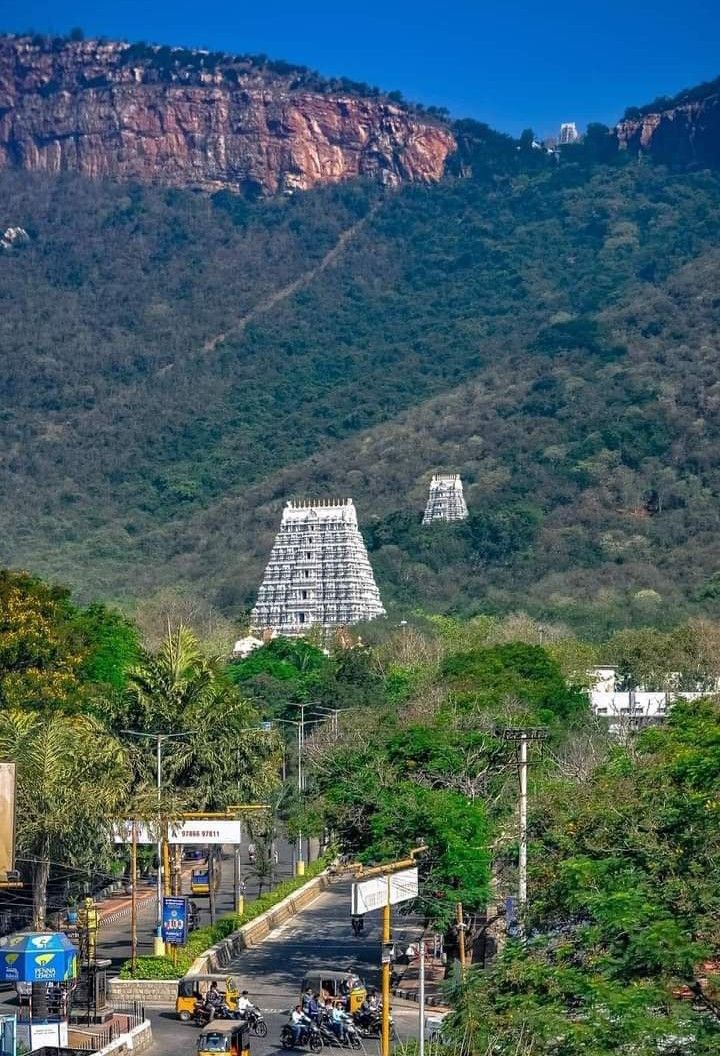T i r u p a t i

A BRIEF HISTORY
V e n k a t e s w a r a T e m p l e
Venkateswara Temple is a landmark Vaishnavite temple situated in the hill town of Tirumala at Tirupati in Chittoor district of Andhra Pradesh, India. The Temple is dedicated to Lord Sri Venkateswara, an incarnation of Vishnu, who is believed to have appeared here to save mankind from trials and troubles of Kali Yuga. Hence the place has also got the name Kaliyuga Vaikuntham and Lord here is referred to as Kaliyuga Prathyaksha Daivam. The temple is also known by other names like Tirumala Temple, Tirupati Temple, Tirupati Balaji Temple. Lord Venkateswara is known by many other names: Balaji, Govinda, and Srinivasa.

The first recorded endowment was made by Pallava queen Samavai in the year 966 CE. She donated many jewels and two parcels of land (one 10 acres and other 13 acres) and ordered to use the revenues generated from that land for the celebration of major festivals in the temple. The Pallava dynasty (9th century), the Chola dynasty (10th century), and Vijayanagara pradhans (14th and 15th centuries) were committed devotees of Venkateswara. The temple gained most of its current wealth and size under the Vijayanagara Empire, present-day Karnataka state, with the donation of diamonds and gold. In the 16th century, Vijayanagara Emperor Krishnadevaraya was a frequent donor and visitor to the temple. His donations of gold and jewels enabled the Ananda Nilayam (inner shrine) roofing to be gilded. On 2 January 1517, Krishnadevaraya installed his own statue in the temple.
After the decline of the Vijayanagara Empire, rulers from states such as the Kingdom of Mysore and the Gadwal Samsthanam worshipped as pilgrims and donated ornaments and valuables to the temple. Maratha general Raghoji I Bhonsle (died 1755) visited the temple and set up a permanent administration for the conduct of worship in the temple. Between 1320 CE and 1369 CE, idols of Ranganatha temple of Srirangapatnam were brought to this temple for safe keeping.
The renowned sweet, Tirupati Laddu which is enriched with dried fruits and also nuts is a registered Geographical Indicator (GI). Around 1,75,000 laddus are prepared daily in the holy kitchen of the temple serving millions of devotees.

– TTD Officials
MAGNIFICIENT HILLS
T h e V a l l e y


Tirumala Hills are part of Seshachalam Hills range. The hills are 853 metres (2,799 ft) above sea level. The Hills comprises seven peaks, representing the seven heads of Adisesha. The temple lies on the seventh peak -Venkatadri, on the southern banks of Sri Swami Pushkarini, a holy water tank. Hence the temple is also referred to as “Temple of Seven Hills”. Tirumala town covers about 10.33 sq mi (26.75 km) in area.
The 27 square kilometers long Tirumala Hill comprises of seven peaks. These peaks represent the seven heads of Adisesha. The peaks are Seshadri, Garudadri, Anjanadri, Neeladri, Vrushabhadri, Venkatadri and Narayanadri.
The Seven Hills Of Tirumala
1) Vrushabadri, Hill of Nandi, the vahana of Lord Shiva.
2) Anjanadri,Hill of Lord Hanuman.
3) Neeladri, Hill of Neela Devi.
4) Garudadri, Hill of Garuda, the vahana of Lord Vishnu.
5) Seshadri,Hill of Sesha, the dasa of Lord Vishnu.
6) Naraynadri,Hill of Narayana (Vishnu).
7) Venkatadri,Hill of Lord Venkateswara.
In Tamil, the Tirumala hills is called the Nedion Kunram where Nedion means “Vishnu” and Kuram means “Hill”. It is a part of the munt Meru where the Adi Varaha decided to reside to help people of the Earth attain salvation. It is the main idea of helping people who are failing to initiate realization of the God through Karma Yoga, Bhakti Yoga or Dhyana Yoga. Tirumala Hills came from Vishnu’s to the Earth by mount Garuda. The seven hills or the seven peaks are believed to be the seven heads of Adisesha (nagraja, i.e, king of all nagas where Adisesha uncoils to move time forward to the future). Men usually wear Dhotis and women Sarees. The practice of tonsure and using Tilaka are major practices in Tirumala Tirupati

The 27 square kilometers long Tirumala Hill comprises of seven peaks. These peaks represent the seven heads of Adisesha. The peaks are Seshadri, Garudadri, Anjanadri, Neeladri, Vrushabhadri, Venkatadri and Narayanadri.
The Seven Hills Of Tirumala
1) Vrushabadri, Hill of Nandi, the vahana of Lord Shiva.
2) Anjanadri,Hill of Lord Hanuman.
3) Neeladri, Hill of Neela Devi.
4) Garudadri, Hill of Garuda, the vahana of Lord Vishnu.
5) Seshadri,Hill of Sesha, the dasa of Lord Vishnu.
6) Naraynadri,Hill of Narayana (Vishnu).
7) Venkatadri,Hill of Lord Venkateswara.
In Tamil, the Tirumala hills is called the Nedion Kunram where Nedion means “Vishnu” and Kuram means “Hill”. It is a part of the munt Meru where the Adi Varaha decided to reside to help people of the Earth attain salvation. It is the main idea of helping people who are failing to initiate realization of the God through Karma Yoga, Bhakti Yoga or Dhyana Yoga. Tirumala Hills came from Vishnu’s to the Earth by mount Garuda. The seven hills or the seven peaks are believed to be the seven heads of Adisesha (nagraja, i.e, king of all nagas where Adisesha uncoils to move time forward to the future). Men usually wear Dhotis and women Sarees. The practice of tonsure and using Tilaka are major practices in Tirumala Tirupati

Tirumala Hills are part of Seshachalam Hills range. The hills are 853 metres (2,799 ft) above sea level. The Hills comprises seven peaks, representing the seven heads of Adisesha. The temple lies on the seventh peak -Venkatadri, on the southern banks of Sri Swami Pushkarini, a holy water tank. Hence the temple is also referred to as “Temple of Seven Hills”. Tirumala town covers about 10.33 sq mi (26.75 km) in area.
THE TEMPLE
T i r u m a l a T i r u p a t i D e v a s t h a n a m ( T T D )
Formed in 1930, the Tirumala Tirupati Devasthanam manages the routine affairs of the temples. It also looks at all the charitable activities of the temple.Subsequently, in 1932 the management of the Temple was handed over to when Tirumala Tirupati Devasthanams (TTD), a non-profit organisation that was established to protect this important religious heritage. The TTD runs various charitable trusts with the proceeds from the pilgrims.
Even Mr. K. Radhakrishnan, the former ISRO chairman had visited the temple to take the divine blessings of the Lord Balaji before every satellite launch.

experiences
Become a Member
The most luxurious Spiritual & Heritage Club in India. Be a part of an exclusive club of devotees. Experience world-class service for the next 20 years.

